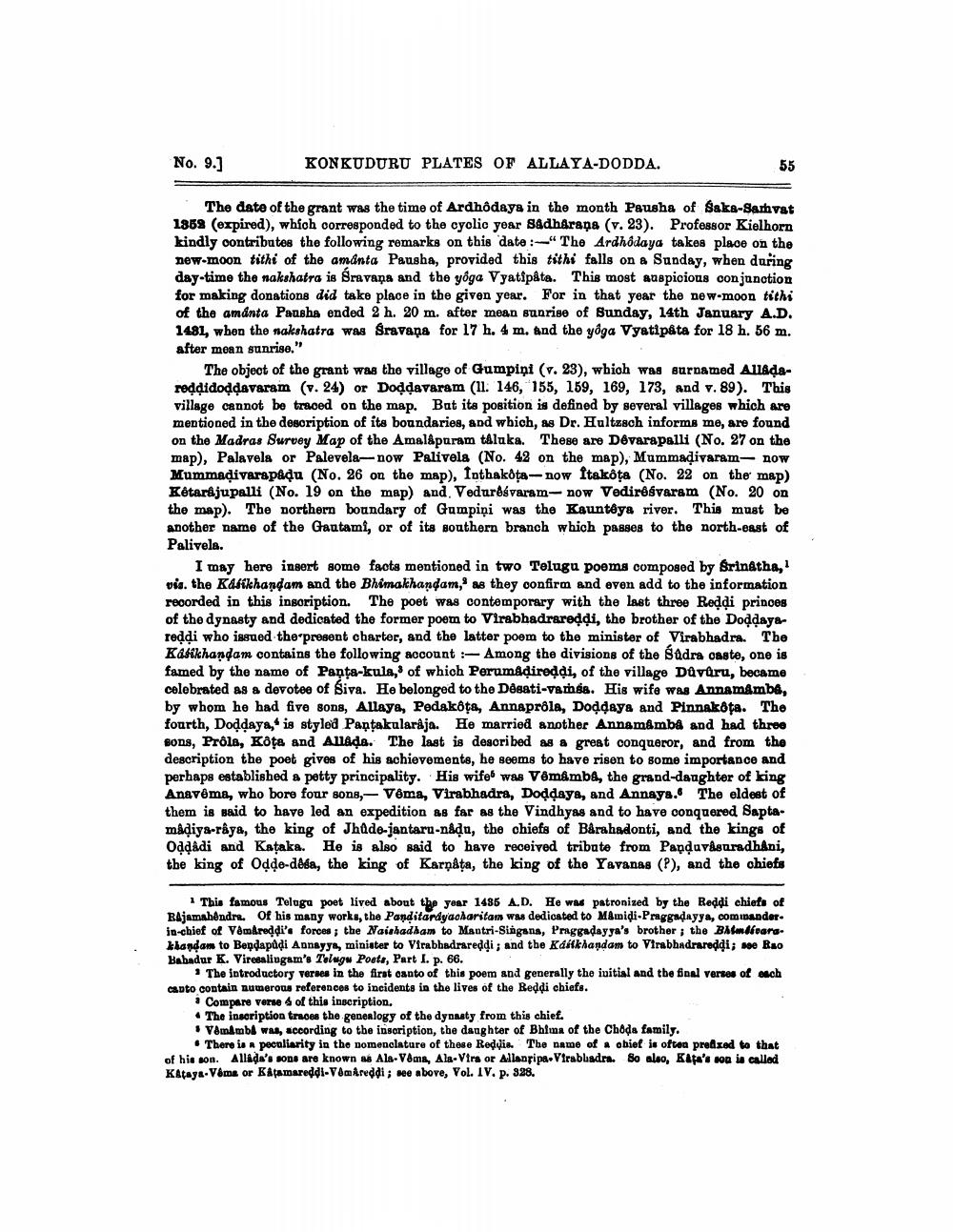________________
No. 9.]
KONKUDURU PLATES OF ALLAYA-DODDA.
55
The date of the grant was the time of Ardhôdays in the month Pausha of Saka-Sarhvat 1859 (expired), which corresponded to the cyclic year Sådhåraņa (v. 23). Professor Kielhorn kindly contributes the following remarks on this date :-“The Ardhôdaya takes place on the new-moon tithi of the amanta Pausha, provided this tithi falls on a Sunday, when during day-time the nakshatra is Sravana and the yôga Vyat påta. This most auspicious conjunction for making donations did take place in the given year. For in that year the new-moon tithi of the amanta Pausha ended 2 h. 20 m. after mean sunrise of Sunday, 14th January A.D. 1481, when the nakshatra was Sravana for 17 h. 4 m. and the yoga Vyatipata for 18 h. 56 m. after mean sunrise."
The object of the grant was the village of Gumpiņi (v. 23), which was surnamed Aladareddidoddavaram (v. 24) or Doddavaram (1l. 146, 155, 159, 169, 173, and v. 89). This village cannot be traced on the map. But its position is defined by several villages which are mentioned in the description of its boundaries, and which, as Dr. Hultzsch informs me, are found on the Madras Survey Map of the Amalapuram tdluka. These are Devarapalli (No. 27 on the map), Palavels or Palevela-now Palivela (No. 42 on the map), Mummadivaram- now Mummadivarapadu (No. 26 on the map), Inthakota-now Itakota (No. 22 on the map) Kétardjupalli (No. 19 on the map) and Vedurdóvaram-now Vedireśvaram (No. 20 on the map). The northern boundary of Gumpiņi was the Kauntêya river. This must be another name of the Gautami, or of its southern branch which passes to the north-east of Palivela.
I may here insert some facts mentioned in two Telugu poems composed by Srinatha, vis. the Kafilhandam and the Bhimakhandam, as they confirm and even add to the information recorded in this insoription. The poet was contemporary with the last three Reddi princes of the dynasty and dedicated the former poem to Virabhadrareddi, the brother of the Doddayreddi who issued the present charter, and the latter poem to the minister of Virabhadra. The Kalikhandam contains the following account :- Among the divisions of the sadra caste, one is famed by the name of Panta-kula, of which Perumadiredai, of the village Davuru, became celebrated as a devotee of Siva. He belonged to the Desati-vamsa. His wife was Annamimba, by whom he had five song, Allaya, Pedakota, Annapróla, Doddaya and Pinnakota. The fourth, Doddaya," is styled Pantakularaja. He married another Annamamba and had three Bons, Prôla, Kota and Allada. The last is described as a great conqueror, and from the description the poet gives of his achievements, he seems to have risen to some importance and perhaps established a petty principality. His wife was Vêmamba, the grand-daughter of king Anavêma, who bore four song,- Véma, Virabhadra, Doddaya, and Annaya. The eldest of them is said to have led an expedition as far as the Vindhyas and to have conquered Saptamadiya-raya, the king of Jhade-jantaru-nådu, the chiefs of Bårahadonti, and the kings of Odaadi and Kataka. He is also said to have received tribute from Panduv suradhani, tbe king of Odde-dega, the king of Karnata, the king of the Yavanas (?), and the chiefs
1 This famous Teluga poet lived about the year 1485 A.D. He was patronized by the Reddi chiefs of Rajamahendre. Of his many works, the Panditardyacharitam was dedicated to M&midi-Praggadayya, commander in-chief of Vendreddi's forces; the Naishadbam to Mantri-Singana, Praggadayya's brother; the BAfmdfraraklandam to Bendapudi Annayya, minister to Virabhadrareddi; and the Káblkhandam to Virabhadrareddi; se Rao Bahadur K. Viresalingam's Telugu Poeta, Part I. p. 66.
• The introductory verses in the first oanto of this poem and generally the initial and the final verses of each capto contain numerous references to incidents in the lives of the Reddi chiefs.
i Compare verse 6 of this inscription. • The inscription traces the genealogy of the dynasty from this chief. • Vámamba was, according to the inscription, the daughter of Bhima of the Choda family.
• There is a peculiarity in the nomenclature of these Reddis. The name of a obief is oftea predsed to that of his son. Allada's sons are known as Ala-Vama, Ala-Vira or Allanripa.Virabhadra. So also, Kate's son is called Kataga-Vama or Katamareddi-Vem&reddi ; see above, Vol. IV. p. 328.




